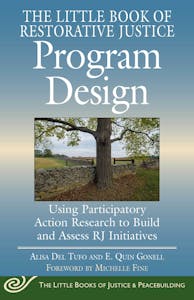A concise and practical guide to bringing the day-to-day practice of restorative justice programs into closer alignment with restorative values.
In the past twenty-five years there has been an explosion of programs, projects, and initiatives that use the terms “restorative justice” or “restorative practices.” This reflects multiple trends: the failures and inhumanity of justice system policies and practices; the unfairness and ineffectiveness of “zero tolerance” and other punitive measures adopted in our schools, and the positive impact of those who have promoted restorative practices for the past several decades around the world. This complex mix has generated an array of programs that utilize restorative ideas and practices in a wide variety of ways, such as court diversion, deeply spiritual circle work, and national and international truth and reconciliation projects. Some of these programs are designed to address incidences of harm that fall within large systems (family group conferencing, victim offender dialogue, circles, COSA, etc.) or in schools where they are often focused on addressing incidences of harm in an effort to change the over reliance on suspensions and expulsions as a way to modify student behaviors. There are other experiments in restorative justice that move this work into community settings, with a focus on healing and the creation of more empathic relationships.
As the authors know from experience, there is often a gap between values and the reality of day to day practice. This Little Book strives to find ways to shrink that gap and to bring our practice and the structures and methods that employ them into closer alignment with restorative values.
Simply put, this book asks, how can we better align restorative theory and practice in our work? In order to have truly restorative programs (programs that strive for consistency between their stated values and their real-life practices) the authors offer some ways to integrate restorative practices and values into the strategies used to design, implement, and assess them. They propose the use of another transformative practice, Participatory Action Research (PAR), as a powerful ally in the work of developing restorative practices and the programs that hold them.
